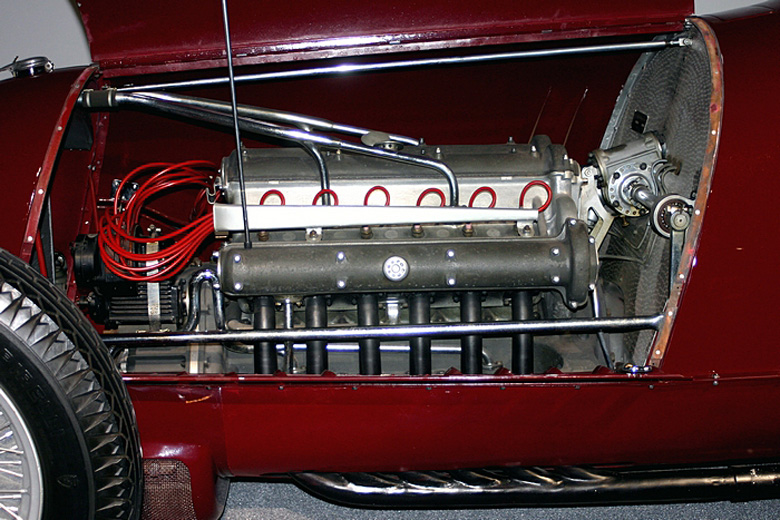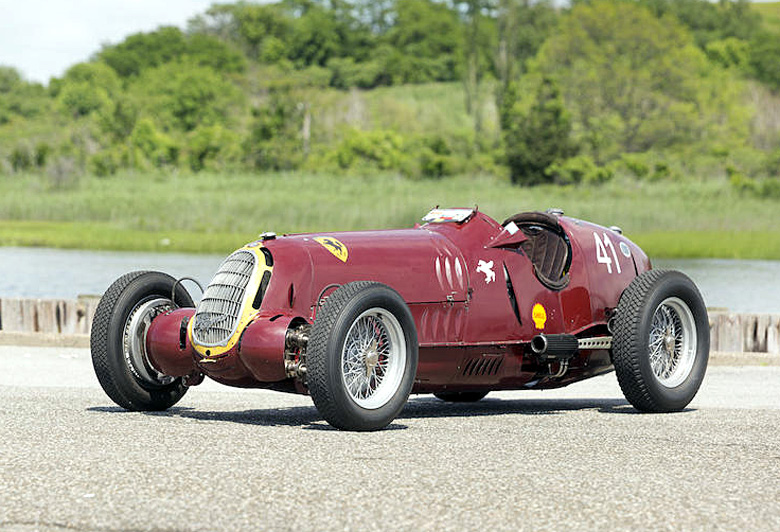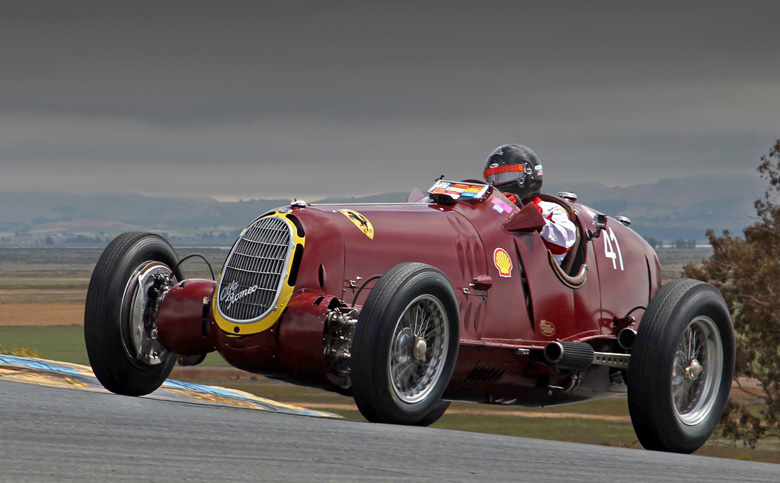By Pete Vack
Montage above by Peter Darnall
From the VeloceToday Archives, January 2017
One might wonder why we are so interested in the Alfa 8C35 cars. An old saying goes that history is written by the survivors; and indeed, this is the case for the 8C35. But in addition to being survivors, the various and sundry 8C35s running today are examples of the only Grand Prix car to give the combined Silver Arrows a real run for the money.
Given the might of the Mercedes and Auto-Union teams, the Alfa Romeo 8C35 had a brief but reasonably successful two seasons in Europe. Designed to be fitted with either a V12 engine, or an 8 cylinder, the 8C35 used a longer version of the famous Alfa 8C 2.3 engine, running almost concurrently with the initially unreliable V12 (12C36) while it was being developed. In 1936 Tazio Nuvolari drove the 8C35 to great victories at Coppa Ciano and the Hungarian GP. In our humble opinion, although Vittorio Jano’s V12 (actually designed by Bruno Trevisan) may have led to his downfall in October of 1937, the 8C and 12 C are underrated and much more successful contenders than results might render. And speaking of results, at the bottom of this article we’ve reproduced the Alfa racing results from the years 1935 to 1937 for your perusal. We thought this an opportune time to provide a brief history of the 8C35 chassis known today.
Of the six 8C35s listed by Fusi, three can be determined to still exist in some form:
50012 frame #8
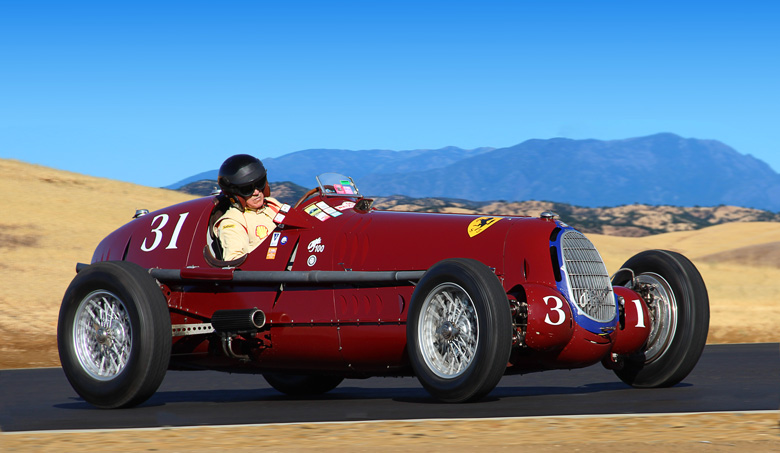
8C35 Frame #8, Engine #5012, Scuderia Ferrari #64. Peter Giddings is driving at Thunderhill West on June 29, 2014. Photo by Peter Darnall.
Rex Mays was an American who raced for the wealthy Bill White who purchased one of the 8C35s which had been brought over for the 1936 Vanderbilt Cup (won by Nuvolari in the new 12C36).
According to Brock Yates in his book, “Ferrari”, White asked Alfa mechanic Attilio Marinoni to remain with the car for a few weeks, during which time Marinoni was said to have spilled all the tuning secrets of the 8C engine. Whatever, Mays widened the body for the still-required riding mechanic for the Indianapolis race in 1937, but retired with overheating problems. The 8C35 was then returned to monoposto form for the Vanderbilt Cup.
For the 1937 race Mays had qualified third fastest, so was behind Caracciola and Rosemeyer, who quickly sped off and battled for the lead. But right behind them, driving the race of his life, was Rex Mays, in a car that was at least two years out of date. Must we say that the crowds went wild when Mays finished ahead of the Auto Union of von Delius and behind Seaman for third place? Nuvolari retired the 12C36 on lap 17 and was never in contention.
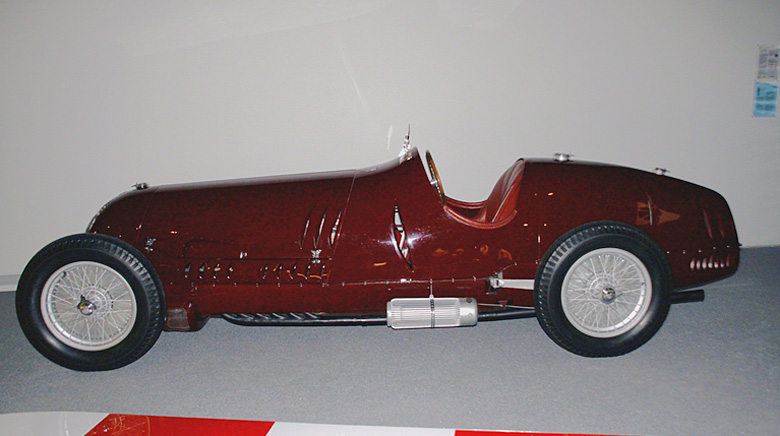
Alfa Romeo GP Tipo C 12 cylinders 1936 at the Alfa Museum is chassis 50012 modified to take a 12C 36 engine. Photo by Roberto Motta
But the 8C35, engine/chassis #50012, was not done yet. Next, Fred Offenhauser and Ed Winfield got involved with modifying the engine, reducing the bore and stroke from the original 3.8 liters to 3 liters for the new 1938 International regulations. This was quite involved but was done by two geniuses. With a two speed rear end, the old Alfa entered the Indy classic again in 1938 driven by Mays, but retired after 45 laps. In other hands, the Alfa continued to qualify in five more Indy 500s until 1947. Mays went on to more competitive cars. After four pole positions at Indy but no wins, Rex Mays died in a crash at Del Mar, California in 1949.
Sometime after WWII, 50012’s engine was separated from the chassis. The warhorse now had a Chevy six inserted into the chassis, and was eventually found by Michael Agraba, who in turn sold the sad remains to the Alfa Museum in 1968. The museum then fitted the restored chassis with a V12c 36 engine, and as such it is still on display at Arese.
According to Simon Moore the Alfa-Offy engine was found under a workbench in Fresno, California and went through several hands before ending up with Peter Giddings. Giddings then used the engine in his Alfa 8C35 frame #8. As the chassis number cannot at this time be verified, Giddings simply calls this an Alfa Tipo C 8C35 (frame #8/ engine 50012).
In building up Giddings’ current car, Auto Restorations of Christchurch, New Zealand had the benefit of comparing the only fully original 8C35 in existence, chassis #50013. The car is set up as it would have been driven by Nuvolari or Mays. “As far as improvements are concerned, I prefer (in so far as all of my cars are concerned) to wrestle them as original, warts and all”, said Giddings.This means that the handling is “of the era” and as tricky as can be. It is no secret that even Nuvolari hated the handling of the 8C35, with its swing axles. Giddings says “The change from understeer to oversteer (and everything in between) is substantially as a result of one’s right foot. Giddings still owns 50012 frame #8.
50013 The only complete, original Tipo 8C35 in the world.
In 2008, Peter Greenfield was in the enviable position of owning and racing not one but two pre-war Alfa Romeo Grand Prix cars. He kept the crown jewel–50013– for very special events such as the Laguna Seca at Monterey where he had it out for the Shell Ferrari Historics.
It is the most important car, because it is one of the very few pre-war Italian Grand Prix cars to have survived intact through the ages. Plus, what a provenance! There seems to be little doubt that 50013 was raced on occasion by Tazio Nuvolari during the 1936 season. Nuvolari won one of his finest races with an 8C35, the Coppa Ciano. It has not been verified if the Nuvolari 8C35 was indeed 50013, however.
According to Denis Jenkinson, when Hans Ruesch bought it from Scuderia Ferrari near the end of the 1936 season, it was said that this was the car that Nuvolari drove to victory in the Coppa Ciano. Ruesch was no slouch either, taking 50013 to victory at Donington Park on October 6th 1936, won the Brooklands Mountain Championship, and won the Frontieres G.P. in Chimay in 1937, to name a few.
The car changed hands twice and survived the war intact to be sold to Dennis Poore in 1947. Poore drove it to three VSCC Seaman Trophies, numerous other events, and in 1951 won the British Hillclimb Championship. Poore retired himself and the car in 1955 but he kept the car in his collection until his death. In 1995 Peter Giddings acquired 50013, had it restored and campaigned it all over the world, finally parting with it to Peter Greenfield in 2005.
It would pass on to new owners and subsequently was sold at Bonhams Goodwood Revival Auction on September 14, 2013. Details of the ownership nor the whereabouts of Alfa Romeo #50013 are known at this time.
50015C A clone with the engine from 50015
Apparently the actual 8C35 chassis numbered 50015 has long disappeared, so something useful was done with the engine, based on the fact that Grist had access to 50013 and used it for comparisons. Thus, 50015 C (C for clone) was born. This car was built up from the parts of a car found in South America, and uses an engine found by Peter Giddings years ago. Giddings explains, “The clone’s “C” section chassis came out of Argentina, and Paul Grist built a car up around it, using the transaxle out of the dismantled Rex Mays Tipo C (#50012), and fitted with engine #50015, which engine I used to own when it was shoe-horned into a 1932 Alfa Romeo Monza!” Giddings says ‘shoe-horned’ because, according to Giddings, “..whilst the 2.3 8c and 3.8 8c engines look similar, the dual supercharged 3.8 is somewhat longer than the single supercharged 2.3.” Peter Greenfield owned this at the same time he owned and raced 50013. He still owns 50015C and its most recent outing was at the Goodwood Revival this past September.
Alfa Romeo racing results, 1925-1937 courtesy Alfa Romeo by Peter Hull
Related articles:

